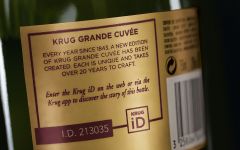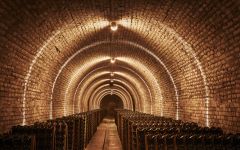Krug Grande Cuvee Brut (169th Edition) with Gift Box
-
Wilfred
Wong -
James
Suckling -
Wine
Spectator - Decanter




Product Details
Your Rating
Somm Note
Winemaker Notes
The Krug Grande Cuvee Brut displays a light golden color and fine, vivacious bubbles, holding a promise of pleasure. Aromas of flowers in bloom, ripe, dried, and citrus fruits, as well as marzipan and gingerbread. Grilled notes and flavors of almond paste, quince, lemon, limoncello, and dried fruit make up the palate.
Krug Grande Cuvee Brut lends itself to a wealth of culinary combinations, it can be enjoyed as an aperitif with Jabugo ham and mature comte or served to accompany oysters, grilled shrimps, as well as desserts such as carrot cake or cheesecake.
Professional Ratings
-
Wilfred Wong of Wine.com
COMMENTARY: The Champagne Krug Grande Cuvée 169ème Édition is another success story from this highly revered Champagne house. I have decades of Grande Cuvée experiences, and am always astounded how consistent Krug GV has been. TASTING NOTES: This edition deftly combines freshness with complexity. Enjoy its aromas and flavors of dried apple skin, tart fresh apples, and a touch of creaminess. Pair with a well-designed charcuterie platter and your favorite classical music. (Tasted: June 23, 2021, San Francisco, CA)
-
James Suckling
Instantly recognizable aromatic depth and complexity here. The DNA of Grande Cuvée looms large on the nose with fresh-baked brioche, crushed almond, subtle baking spices and stony notes, as well as an array of stone fruit. The palate delivers a wide spectrum of citrus, from lemon to orange to grapefruit and beyond. The chardonnay really impresses in a long, concentrated mode. 43% pinot noir, 35% chardonnay and 22% pinot meunier. It contains 40% reserve wine and is composed of 146 different components from 11 different vintages, the youngest being 2013 and the oldest 2000. Drink or hold.
-
Wine Spectator
A vivid Champagne, with a chiseled frame of acidity and a chalky underpinning cloaked in a fine mousse that caresses the palate with its gossamer-like texture. Lovely aromas of coffee liqueur, anise and verbena accent the layered flavors of tangerine, Macadamia nut, brioche and ripe plum, a profile that expands on the long, mouthwatering finish. There's power and expressive character to this, with a delicacy to its fine integration and length. Pinot Noir, Chardonnay and Pinot Meunier.
-
Decanter
The floral bouquet is very fine and elegant but also quite delicate, suffused with touches of slightly candied citrus, but the telltale autolytic note of hazelnuts is less pronounced than usual. There is, however, some almond nuttiness on the palate, as well as racy rectitude and vivacity that give thrust to a long, surprisingly breezy finish. Will benefit from five to 10 years of cellaring. Disgorged January 2020. Dosage: 4.5g/L. Elaborated from 146 wines and 11 different vintages, the oldest of which dates back to 2000. 40% reserve wines.









Krug has always lived up to its reputation as the first and only Champagne House to create exclusively prestige Champagnes every year since its foundation.
The House was established in Reims in 1843, by Joseph Krug, a visionary non-conformist with an uncompromising philosophy. Having understood that the true essence of Champagne is pleasure itself, his dream was to craft the very best Champagne he could offer, every single year, regardless of annual variations in climate. Paying close attention to the vineyard’s character, respecting the individuality of each plot and its wine, as well as building an extensive library of reserve wines from many different years allowed Joseph Krug to fulfil his dream.
With a very original approach to Champagne making, he decided to go beyond the notion of vintage to create the most generous expression of Champagne, every year. Thus, he founded a House in which all Champagnes are of the same level of distinction.
Six generations of the Krug family have perpetuated this dream, enriching the founder’s vision and savoir faire.
Further elaborating on the notion of individuality, for Krug’s Cellar Master Julie Cavil, each plot of grapes, through its wine, is like a single ingredient to a chef: carefully selected, and critical to the final composition. Each year, Krug honors this philosophy by inviting chefs from around the world to interpret a single ingredient, crafting unexpected recipes to pair with a glass of Krug Grande Cuvée or Krug Rosé. This year’s ingredient is the Onion.
The unspoken onion is a key component of almost every fundamental recipe from stocks, sauces and stews to baked goods and roasts. Its multifaceted expressions beautifully marry both the fullness of flavors and aromas of Krug Grande Cuvée the elegance and boldness of Krug Rose.

A term typically reserved for Champagne and Sparkling Wines, non-vintage or simply “NV” on a label indicates a blend of finished wines from different vintages (years of harvest). To make non-vintage Champagne, typically the current year’s harvest (in other words, the current vintage) forms the base of the blend. Finished wines from previous years, called “vins de reserve” are blended in at approximately 10-50% of the total volume in order to achieve the flavor, complexity, body and acidity for the desired house style. A tiny proportion of Champagnes are made from a single vintage.
There are also some very large production still wines that may not claim one particular vintage. This would be at the discretion of the winemaker’s goals for character of the final wine.

Associated with luxury, celebration, and romance, the region, Champagne, is home to the world’s most prized sparkling wine. In order to bear the label, ‘Champagne’, a sparkling wine must originate from this northeastern region of France—called Champagne—and adhere to strict quality standards. Made up of the three towns Reims, Épernay, and Aÿ, it was here that the traditional method of sparkling wine production was both invented and perfected, birthing a winemaking technique as well as a flavor profile that is now emulated worldwide.
Well-drained, limestone and chalky soil defines much of the region, which lend a mineral component to its wines. Champagne’s cold, continental climate promotes ample acidity in its grapes but weather differences from year to year can create significant variation between vintages. While vintage Champagnes are produced in exceptional years, non-vintage cuvées are produced annually from a blend of several years in order to produce Champagnes that maintain a consistent house style.
With nearly negligible exceptions, . These can be blended together or bottled as individual varietal Champagnes, depending on the final style of wine desired. Chardonnay, the only white variety, contributes freshness, elegance, lively acidity and notes of citrus, orchard fruit and white flowers. Pinot Noir and its relative Pinot Meunier, provide the backbone to many blends, adding structure, body and supple red fruit flavors. Wines with a large proportion of Pinot Meunier will be ready to drink earlier, while Pinot Noir contributes to longevity. Whether it is white or rosé, most Champagne is made from a blend of red and white grapes—and uniquely, rosé is often produce by blending together red and white wine. A Champagne made exclusively from Chardonnay will be labeled as ‘blanc de blancs,’ while ones comprised of only red grapes are called ‘blanc de noirs.’
